
People take shelter under a tent decorated with a Chilean flag after evacuating their homes due to earthquakes in Alto Hospicio, Chile, Thursday, April 3, 2014. Coastal residents of Chile’s far north spent a second sleepless night outside their homes as major aftershocks continued Thursday following a magnitude-8.2 earthquake that damaged several thousand homes and caused six deaths. (AP)
IQUIQUE, Chile — Coastal residents of Chile’s far north spent a second sleepless night outside their homes as major aftershocks continued Thursday following a magnitude-8.2 earthquake that damaged several thousand homes and caused six deaths.
No new major damage or casualties were reported, and a heavy police and military presence kept order.
The infrastructure in the area is nearly entirely intact, but with aftershocks continuing, life has been anything but normal. Power remains out in many areas, and hospitals were handling only emergencies. Schools were closed, and large supermarkets and gas stations coordinated their reopenings Thursday with police and military to avoid problems with long lines of customers.
After a magnitude-7.6 aftershock struck just before midnight Wednesday, Chile’s Emergency Office and navy issued a tsunami alert, and for two hours ordered everyone living in low-lying areas along the country’s entire 2,500-mile (4,000-kilometer) Pacific coastline to evacuate.
Among those moved inland was President Michelle Bachelet, who was in the city of Arica assessing damage in the north from Tuesday night’s powerful quake.
“I was evacuated like all citizens. One can see that the people are prepared,” she tweeted early Thursday.
Chile’s evacuation order was lifted at around 2 a.m. Thursday. Some 900,000 people also were affected the night before when the entire coast was evacuated for several hours after Tuesday’s bigger quake, although the tsunami proved small.
A 6.1-magnitude aftershock 47 miles (76 kms) southwest of Iquique shook the area again late Thursday.
The repeated aftershocks have shaken buildings and sent people running into the streets in the port of Iquique, the largest city closest to the epicenter. About 45 minutes before the 7.6 quake, a magnitude-6.5 aftershock also rattled Iquique. The shaking loosened more landslides near Alto Hospicio, a poor area at the entrance to Iquique where about 2,500 homes had been damaged in Tuesday’s larger quake.
The Ministry of Education suspended classes again in schools in the north for Thursday, while the region’s top prosecutor, Manuel Guerra, said his office is taking action against speculators who sharply raised prices for bread, water, milk and diapers. “They will be detained and charged,” Guerra tweeted, calling on the community to denounce “intolerable” abuses.
The largest aftershock was felt across the border in southern Peru, where people in the cities of Tacna and Arequipa fled buildings in fear. Police Lt. Freddy Cuela in Tacna said no damage or injuries were reported. Peru’s navy tweeted a tsunami alert for the country’s extreme southern coast, which is next to the Chilean region hit by the quakes.
Authorities have reported six deaths, but didn’t rule out the possibility others could have been killed in older structures made of adobe in remote communities that weren’t immediately accessible.
The tsunami after Tuesday night’s quake caused the sea to rise only 8 feet (2.5 meters) in Iquique, but that was enough to sink and damage many fishing boats, lifting some onto city streets and piling others up in the harbor.
Still, as Bachelet deployed hundreds of anti-riot police and soldiers to prevent looting and round up escaped prisoners, it was clear the loss of life and property could have been much worse.
The mandatory evacuations have been announced through cellphone text messages and Twitter, and reinforced by blaring sirens in neighborhoods where people regularly practice earthquake drills. But many Chileans have not downloaded the smartphone application that can alert them to evacuation orders, and some communities still lack warning sirens.
Chile is one of the world’s most earthquake-prone countries, and tsunamis are a particular danger because the fault zone lies just offshore, where the Nazca tectonic plate plunges beneath the South American plate.
RELATED STORIES
Tsunami warning raised after 8.0-magnitude quake hits Chile
Another powerful earthquake rocks northern Chile
Experts: Chile’s magnitude-8.2 quake not ‘the big one’